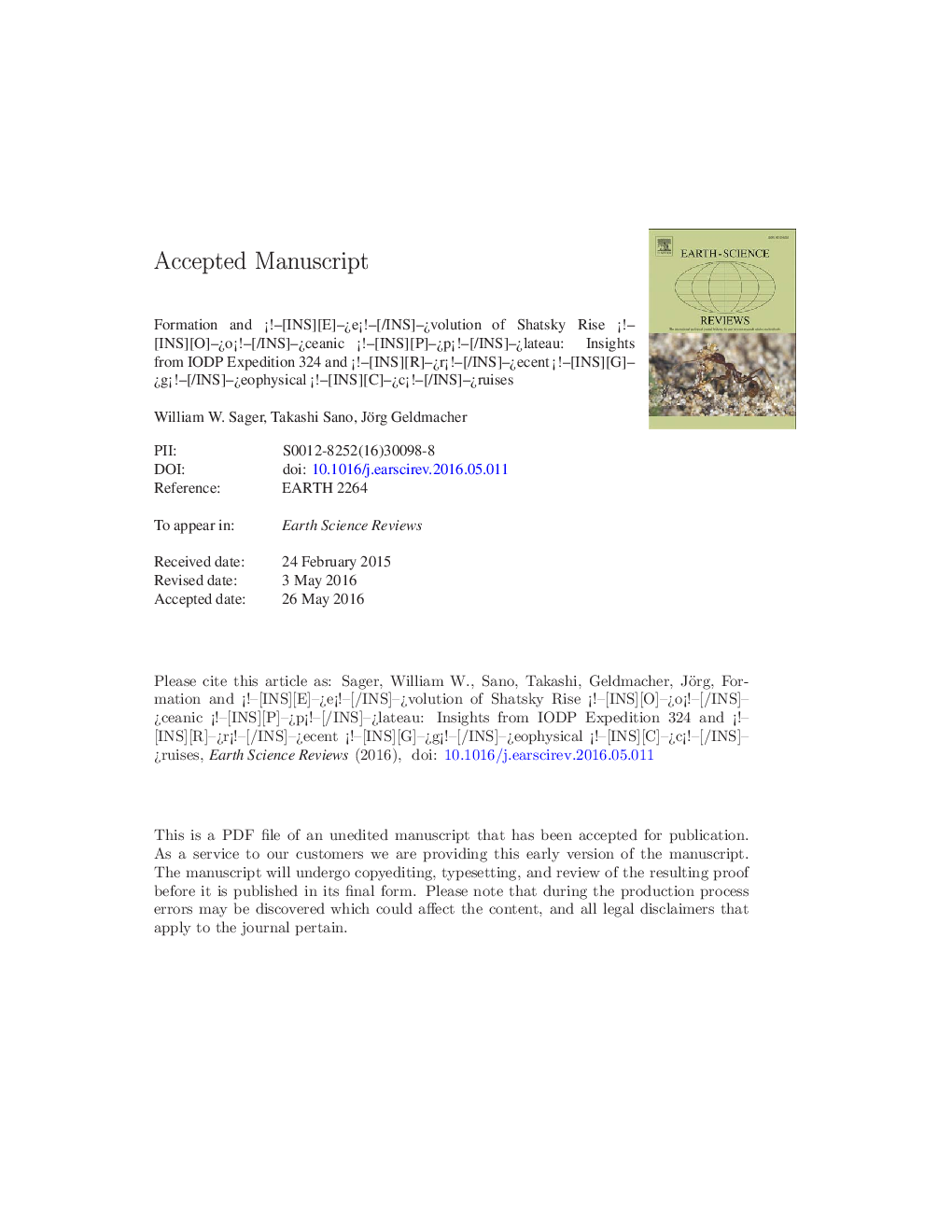| کد مقاله | کد نشریه | سال انتشار | مقاله انگلیسی | نسخه تمام متن |
|---|---|---|---|---|
| 6442856 | 1639943 | 2016 | 129 صفحه PDF | دانلود رایگان |
عنوان انگلیسی مقاله ISI
Formation and evolution of Shatsky Rise oceanic plateau: Insights from IODP Expedition 324 and recent geophysical cruises
دانلود مقاله + سفارش ترجمه
دانلود مقاله ISI انگلیسی
رایگان برای ایرانیان
کلمات کلیدی
Large igneous provinces - استان های آذربایجان بزرگPacific Ocean - اقیانوس آرامSeismic reflection - انعکاس لرزه ایPlate tectonics - زمین ساخت صفحهای، کتونیک صفحهایShatsky Rise - شاتسکی ظهورSeismic refraction - شکست لرزه ایOceanic plateau - فلات اقیانوسیGeochemistry - ژئوشیمیGeochronology - ژئوکرونولوژی Mantle plume - گوشت خوکIntegrated Ocean Drilling Program - یکپارچه برنامه حفاری اقیانوس
موضوعات مرتبط
مهندسی و علوم پایه
علوم زمین و سیارات
زمین شناسی
پیش نمایش صفحه اول مقاله

چکیده انگلیسی
Recent research from the Shatsky Rise in the western Pacific Ocean provides new insights on the formation and evolution of this oceanic plateau as well as tests of mantle models to explain anomalous large igneous province (LIP) volcanism. Recent Shatsky Rise studies cored the igneous pile (Integrated Ocean Drilling Program Expedition 324), imaged the interior with seismic refraction and multichannel seismic reflection data, and mapped magnetic anomalies adjacent to the plateau to provide new constraints on its tectonic history. Coring data show that Tamu Massif, the largest edifice within Shatsky Rise, is characterized by massive sheet flows, similar to flows caused by voluminous eruptions in continental flood basalts. Core data also indicate that the massive eruptions waned as the plateau evolved and smaller edifices were built. Seismic data show intrabasement reflectors within Tamu Massif that indicate volcanism from its center, indicating that this is an enormous shield volcano with abnormally low flank slopes and thick crust (~ 30 km). Paleomagnetic data record minimal geomagnetic field variations, consistent with the inference of massive, rapid volcanism. Altogether, the physical picture indicates that Shatsky Rise was built by massive, rapid eruptions that formed enormous volcanoes. Geochronologic data support the previously inferred age progression, with the volcanic massifs formed along the trace of a triple junction starting from Tamu Massif and becoming progressively younger to the northeast. These data weaken support for rapid emplacement because they show that the last eruptions atop Tamu Massif encompassed several million years between the final massive flows as well as a long hiatus of ~ 15 Myr until late stage eruptions that formed a summit ridge. They may also indicate that the last eruptions on Tamu and Ori massifs occurred while the triple junction was hundreds of kilometers distant. Furthermore, magnetic anomaly data indicate that the plate boundary reorganization associated with Shatsky Rise formation occurred several million years prior to the first Tamu Massif eruptions, suggesting plate boundary control of Shatsky Rise initiation. Geochemical and isotopic data show that Shatsky Rise rocks are variably enriched, with the majority of lavas being similar to mid-ocean ridge basalts (MORB). However, the data indicate deeper (> 30 km) and higher partial degree of melting (15-23%) as compared with normal MORB. Melting models indicate that the magma experienced a mantle temperature anomaly, albeit only a small one (~ 50 °C). Some lava compositions suggest the involvement of recycled subducted slab material. Recent investigations of Shatsky Rise initially envisaged a competition between two end-member models: the thermal plume head and the fertile mantle melting beneath plate extension (aka, plate model). Both hypotheses find support from new data and interpretations, but both do not fit some data. As a result, neither model can be supported without reservation. Noting that most basaltic oceanic plateaus have formed at triple junctions or divergent plate boundaries, we suggest that this dichotomy is artificial. Oceanic plateau volcanism is anomalous and focused at spreading ridges for reasons that are still poorly understood, mainly owing to uncertainties about mantle convection and geochemical reservoirs. Shatsky Rise investigations have vastly improved our understanding of the formation of this oceanic plateau, but highlight that important work remains to understand the underlying nature of this volcanism.
ناشر
Database: Elsevier - ScienceDirect (ساینس دایرکت)
Journal: Earth-Science Reviews - Volume 159, August 2016, Pages 306-336
Journal: Earth-Science Reviews - Volume 159, August 2016, Pages 306-336
نویسندگان
William W. Sager, Takashi Sano, Jörg Geldmacher,